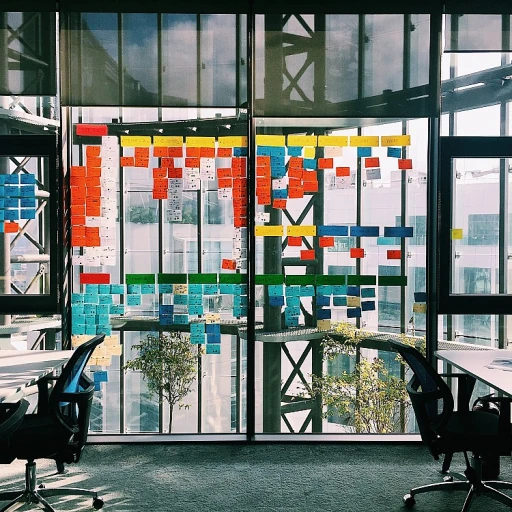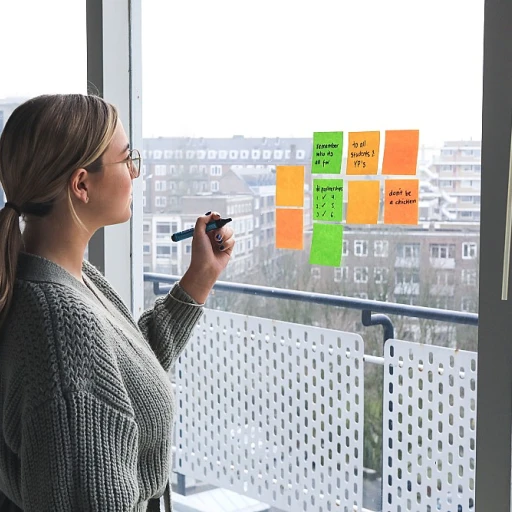Understanding Visual Management in the Indian Context
The Importance of Visual Communication in Indian Workspaces
In the dynamic world of Indian business, where efficiency is key to surviving intense competition, adapting innovative techniques like visual management is becoming vital. Rooted deeply in lean methodologies, visual management is all about simplifying communication within teams by using visual aids. It's particularly significant in India, given the diverse linguistic landscapes across various states, making non-verbal communication more effective.
Visual management tools such as kanban boards, performance metrics, and visual controls have proven to be effective in ensuring that all team members are on the same page regardless of their language proficiency. By presenting complex data into easy-to-understand visual formats, these tools not only enhance clarity but also assist in real-time decision-making and problem-solving processes.
The integration of visual management in Indian offices doesn't just bolster communication; it facilitates continuous improvement—a core principle of lean manufacturing. By regularly updating and displaying status boards and improvement indicators, office managers can effectively track progress and optimize production workflows. This empowers teams to achieve sustained excellence in their projects and day-to-day work.
Moreover, understanding visual management can significantly overhaul how an office functions. From the status of projects to real-time updates of processes and performance, visual aids revolutionize employee engagement and efficiency, reducing unnecessary time wastage. To delve deeper into optimizing office operations, consider exploring optimizing office layouts as another vital component in enhancing overall productivity.
Key Benefits of Visual Management for Office Managers
Advantages of Implementing Visual Management Techniques
In the fast-paced realm of Indian offices, visual management techniques can revolutionize how office managers handle daily operations. These strategies offer an array of benefits, particularly when it comes to boosting team performance and enhancing real-time decision-making. By leveraging visual tools, office managers can achieve more streamlined processes and a more effective workplace.
Visual management, often used in lean manufacturing, provides an immediate insight into the progress of tasks, problem-solving methodologies, and production status. This transparency reduces misunderstandings and keeps team members aligned on project objectives. Using management boards such as kanban boards ensures that everyone can see the current status of workflows and make informed contributions.
- Enhanced Team Collaboration: Implementing visual controls and visual boards keeps team members engaged by sharing performance metrics and process updates. Regular updates make it easier for everyone to track changes and adapt quickly without needing lengthy meetings.
- Efficient Time Management: By utilizing visual management boards, managing work becomes much more straightforward. The system provides clarity on deadlines, project timelines, and task responsibilities, which fosters a standard work environment and encourages continuous improvement.
- Effective Decision Making: With visual project management systems in place, office managers can quickly gauge progress, identify bottlenecks, and implement immediate corrective actions. This real-time feedback loop is essential for maintaining high-performance levels and ensuring smooth workflow execution.
These benefits not only enhance productivity but also make a compelling case for investing in visual management tools. They serve as an essential step towards refined project management and process improvement in Indian offices. For more detail on how to effectively adopt these methodologies, it's vital to understand the balance between internal and external stakeholder demands that can be further explored in the
opportunities and challenges faced by reception roles in diverse working environments.
Implementing Visual Management Solutions Effectively
An effective approach to implementing visual management tools in Indian offices involves building a strategic framework that considers the diverse nature of office environments across regions. Understanding the nuances and tailoring visual controls to meet specific team needs can enhance communication and streamline processes.
Adopting lean principles, such as Kanban boards, can help offices manage work projections and track progress in real time. These visual tools enable team members to observe the flow of a project and identify bottlenecks quickly, encouraging proactive problem solving.
A management board serves as a real-time indicator of a team's performance and production status, promoting transparency and accountability. This system aids in visual project management by displaying pertinent information, enabling team members to make informed decisions rapidly.
Moreover, integrating effective visual management tools, such as standard work instructions and performance metrics, can facilitate continuous improvement. This not only drives productivity but also fosters a culture of excellence in the workplace.
For a more comprehensive discussion on enhancing team efficiency, visit our
enhancing team efficiency with decision making tools blog post.
Overcoming Challenges in Visual Management Adoption
Challenges of Visual Management Integration in the Workplace
Adopting visual management techniques in Indian offices, though beneficial, brings its own set of challenges. As office managers consider these techniques for boosting workplace efficiency, they must be prepared to address potential hurdles.
Firstly, resistance to change is a common issue. Employees accustomed to traditional workflows might be hesitant to embrace new visual tools like kanban boards or management boards that emphasize real-time updates and lean project management. To mitigate this, it is crucial to involve team members in the process, providing them with adequate training and explaining the benefits such as improved decision-making and performance metrics tracking.
Another concern is the integration of visual systems within existing processes and ensuring they complement the ongoing manufacturing or administrative workflows. Compatibility issues can arise if the visual controls or boards are not properly aligned with the standard work and production systems. Office managers should conduct a careful assessment of current processes to ensure a smooth transition.
Resource allocation also presents a challenge. Implementing a new visual management system might require additional resources, both in terms of time and finances. Setting up these systems, especially if they involve technological solutions, demands a commitment that must be balanced with the ongoing business needs.
Finally, maintaining continuous improvement is essential. It's not enough to set up visual management tools; they must be consistently evaluated and refined to keep pace with organizational goals and performance metrics. Regular feedback and problem-solving sessions can help in identifying areas for improvement in the system.
Despite these challenges, the advantages of visual management, when implemented effectively, can lead to significant improvements in workflow efficiency and team performance. Understanding and anticipating the potential obstacles can help managers integrate these systems more successfully and realize the full benefits of a visual approach to management.
Case Studies: Successful Visual Management in Indian Companies
Real-World Impact of Visual Management Adoption
In harnessing the power of visual management, many Indian companies have exemplified significant gains in workplace efficiency and productivity. A number of organizations, through the adoption of visual controls and lean manufacturing processes, have profoundly transformed their operations.
One notable example is a well-known manufacturing company that successfully implemented kanban boards to streamline their production workflow. By integrating these management boards, the company enhanced its project management capabilities, resulting in improved communication and collaboration among team members. This system enabled the team to track work progress in real time, making it easier to identify bottlenecks and prioritize tasks effectively.
The use of visual tools such as management boards and performance metrics enabled another innovative firm in the IT sector to foster continuous improvement. By adopting these management systems, the company observed not only an increase in productivity but also a notable reduction in project cycle time. The ability to identify and address issues with immediate problem solving strategies led to numerous process improvements and informed decision making.
An automobile company, faced with manufacturing inconsistencies, utilized visual project management tools to enhance their lean management strategies. They achieved significant progress in standard work workflows and lean manufacturing initiatives, leading to higher performance and a resilient production system. Moreover, implementing a robust visual management system augmented their capacity to maintain a consistent status overview, allowing for swift responses to changing circumstances.
These case studies reflect the tangible benefits that Indian companies are realizing by embedding visual management techniques into their operational frameworks. By leveraging these tools, teams are not only meeting deadlines but also fostering an environment of continuous innovation and performance improvement. As companies continue to adapt, the emphasis on visual management is expected to drive further advancements in various sectors across India.
Future Trends in Visual Management for Indian Offices
Future Prospects in Visual Management for Indian Workplaces
The rapid evolution of visual management techniques predicts an exciting future for Indian offices. As companies increasingly embrace these methodologies, several trends offer promising avenues for enhancing workplace efficiency.
Firstly, the integration of advanced technologies with visual management is on the rise. More Indian companies are leveraging real-time project management tools that utilize visual controls to streamline processes and enhance team efficiency. This trend helps companies maintain perfect balance in performance metrics, allowing team members to quickly identify problems and progress in real time.
There is also a growing preference for lean manufacturing principles. Lean management focuses on continuous improvement and optimizing standard work protocols. Visual tools, like kanban boards and management boards, play a crucial role in this context. These tools provide clear visibility of status and process flows, supporting effective decision making and problem solving among teams.
Additionally, the culture of collaboration in Indian offices is getting a boost through the use of visual boards. These boards serve as a communal resource, aiding teams in identifying areas for improvement and driving discussions around performance metrics, effectively fostering a collective approach to achieving goals.
Finally, as companies continue to benefit from the implementation of visual project management systems, continuous innovation in visual management techniques will remain essential. By staying informed and adaptable to these advancements, office managers can ensure sustained improvements in productivity and efficiency across their organizations.














